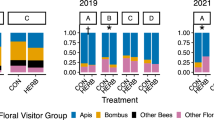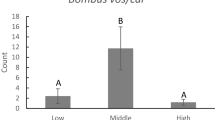Abstract
Ungulate browsing of flowering stalks of the semelparous herb Ipomopsis aggregata leads to regrowth of lateral inflorescences, a response that has been reported to yield overcompensation in some cases (browsed plants with higher reproductive success than unbrowsed), but undercompensation in others. Little is known about the mechanisms that cause such variable tolerance to herbivory. We explored one possible mechanism—variation in effects of browsing on pollination—by clipping I. aggregata inflorescences to mimic browsing, observing subsequent visits by pollinators and nectar-robbers, and adding pollen by hand to flowers of some clipped and unclipped plants. Clipping reduced floral display size and increased inflorescence branching, but neither hummingbirds, the primary pollinators, nor nectar-robbing bumblebees showed any preference for unclipped versus clipped plants. Clipping delayed flowering; this shift in phenology caused clipped plants to miss the peak of hummingbird activity and to have lower per-flower visitation rates than unclipped controls in one year, but to have greater overlap with birds and higher visitation rates in the subsequent year. In three sites and 2 years, clipped plants exposed to natural pollination suffered extreme undercompensation, producing on average only 16% as many seeds as unclipped controls. This was not directly attributable to clipping effects on pollination, however, because clipped plants were unable to increase fecundity when provided with supplemental pollen by hand. Taken altogether, our results suggest that compensation was constrained less by indirect effects of browsing on pollination than by its direct impacts on resource availability and hence on the ability of plants to regrow lost inflorescence tissue and to fill seeds. Exploring the physiological and developmental processes involved in regrowth of inflorescences and provisioning of seeds is a promising future direction for research designed to understand variation in browsing tolerance.

Similar content being viewed by others
References
Anderson LL, Paige KN (2003) Multiple herbivores and coevolutionary interactions in an Ipomopsis hybrid swarm. Evol Ecol 17:139–156
Belsky AJ (1986) Does herbivory benefit plants? A review of the evidence. Am Nat 127:870–892
Bergelson J, Crawley MJ (1992a) The effects of grazers on the performance of individuals and populations of scarlet gilia, Ipomopsis aggregata. Oecologia 90:435–444
Bergelson J, Crawley MJ (1992b) Herbivory and Ipomopsis aggregata: the disadvantages of being eaten. Am Nat 139:870–882
Brody AK (1992) Oviposition choices by a predispersal seed predator (Hylemya sp.): correspondence with hummingbird pollinators, and the role of plant size, density and floral morphology. Oecologia 91:56–62
Brody AK (1997) Effects of pollinators, herbivores, and seed predators on flowering phenology. Ecology 78:1624–1631
Brody AK, Mitchell RJ (1997) Effects of experimental manipulation of inflorescence size on pollination and pre-dispersal seed predation in the hummingbird-pollinated plant Ipomopsis aggregata. Oecologia 110:86–93
Brody AK, Morita SI (2000) A positive association between oviposition and fruit set: female choice or manipulation? Oecologia 124:418–425
Cabin RJ, Mitchell RJ (2002) To Bonferroni or not to Bonferroni: when and how are the questions. Bull Ecol Soc Am 81:246–248
Calder WA (1987) Southbound through Colorado: migration of rufous hummingbirds. Natl Geogr Res 3:40–51
Calder WA (1991) Territorial hummingbirds. Natl Geogr Res 7:56–69
Campbell DR (1991) Effects of floral traits on sequential components of fitness in Ipomopsis aggregata. Am Nat 137:713–737
Campbell DR, Halama KJ (1993) Resource and pollen limitations to lifetime seed production in a natural plant population. Ecology 74:1043–1051
Campbell DR, Waser NM, Price MV, Lynch EA, Mitchell RJ (1991) Components of phenotypic selection: pollen export and flower corolla width in Ipomopsis aggregata. Evolution 45:1458–1467
De Jong TJ, Waser NM, Price MV, Ring RM (1992) Plant size, geitonogamy, and seed set in Ipomopsis aggregata. Oecologia 89:310–315
Elam DR, Linhart YD (1988) Pollination and seed production in Ipomopsis aggregata: differences among and within flower color morphs. Am J Bot 75:1262–1274
Freeman RS, Neefus CD, Brody AK (2003) The effects of elevation and herbivory on the reproductive success of Ipomopsis aggregata (Polemoniaceae). Oecologia (in press)
Gronemeyer PA, Dilger BJ, Bouzat JL, Paige KN (1997) The effects of herbivory on paternal fitness in scarlet gilia: better moms also make better pops. Am Nat 150:592–602
Hainsworth FR, Wolf LL, Mercier T (1985) Pollen limitation in a monocarpic species, Ipomopsis aggregata. J Ecol 73:263–270
Irwin RE, Brody AK (1999) Nectar-robbing bumblebees reduce the fitness of Ipomopsis aggregata (Polemoniaceae). Ecology 80:1703–1712
Juenger T, Bergelson J (1997) Pollen and resource limitation of compensation to herbivory in scarlet gilia, Ipomopsis aggregata. Ecology 78:1684–1695
Juenger T, Bergelson J (1998) Pairwise versus diffuse natural selection and the multiple herbivores of scarlet gilia, Ipomopsis aggregata. Evolution 52:1583–1592
Juenger T, Bergelson J (2000a) Does early season browsing influence the effect of self-pollination in scarlet gilia? Ecology 81:41–48
Juenger T, Bergelson J (2000b)The evolution of compensation to herbivory in scarlet gilia, Ipomopsis aggregata: Herbivore-imposed natural selection and the quantitative genetics of tolerance. Evolution 54:764–777
Krupnick GA, Weis AE (1999) The effect of floral herbivory on male and female reproductive success in Isomeris arborea. Ecology 80:135–149
Krupnick GA, Weis AE, Campbell DR (1999) The consequences of floral herbivory for pollinator service to Isomeris arborea. Ecology 80:125–134
Lehtila K, Strauss SY (1997) Leaf damage by herbivores affects attractiveness to pollinators in wild radish, Raphanus raphanistrum. Oecologia 111:396–403
Lennartsson T, Tuomi J, Nilsson P (1997) Evidence for an evolutionary history of overcompensation in the grassland biennial Gentianella campestris (Gentianaceae). Am Nat 149:1147–1155
Marquis RJ (1992) Selective impact of herbivores. In: Fritz RS, Simms EL (eds) Plant resistance to herbivores and pathogens: ecology, evolution, and genetics. University of Chicago Press, Chicago, pp 301–325
Maschinski J, Whitham TG (1989) The continuum of plant responses to herbivory: the influence of plant association, nutrient availability, and timing. Am Nat 134:1–19
Mayfield MM, Waser NM, Price MV (2001) Exploring the “most effective pollinator principle” with complex flowers: bumblebees and Ipomopsis aggregata. Ann Bot 88:591–596
McNaughton SJ (1983) Compensatory plant growth as a response to herbivory. Oikos 40:329–336
Mitchell RJ (1994) Effects of floral traits, pollinator visitation, and plant size on Ipomopsis aggregata fruit production. Am Nat 143:871–889
Mothershead K, Marquis RJ (2000) Fitness impacts of herbivory through indirect effects on plant-pollinator interactions in Oenothera macrocarpa. Ecology 81:30–40
Paige KN (1994) Herbivory and Ipomopsis aggregata: differences in response, differences in experimental protocol: a reply to Bergelson and Crawley. Am Nat 143:739–749
Paige KN (1999) Regrowth following ungulate herbivory in Ipomopsis aggregata: geographic evidence for overcompensation. Oecologia 118:316–323
Paige KN, Whitham TG (1987a) Overcompensation in response to mammalian herbivory: the advantage of being eaten. Am Nat 129:407–416
Paige KN, Williams B, Hickox T (2001) Overcompensation through the paternal component of fitness in Ipomopsis arizonica. Oecologia 128:72–76
Price MV, Waser NM (1998) Effects of experimental warming on plant reproductive phenology in a subalpine meadow. Ecology 79:1261–1271
Santandreu M, Lloret F (1999) Effect of flowering phenology and habitat on pollen limitation in Erica multiflora. Can J Bot 77:734–743
SAS (2000) JMP statistics and graphics guide. SAS Institute, Cary, N.C.
Schultz JC (2002) How plants fight dirty. Nature 416:267
Stowe KA, Marquis RJ, Hochwender CG, Simms EL (2000) The evolutionary ecology of tolerance to consumer damage. Annu Rev Ecol Syst 31:565–595
Strauss SY (1997) Floral characters link herbivores, pollinators, and plant fitness. Ecology 78:1640–1645
Strauss SY, Agrawal AA (1999) The ecology and evolution of plant tolerance to herbivory. Trends Ecol Evol 14:179–185
Strauss SY, Conner JK, Rush SL (1996) Foliar herbivory affects floral characters and plant attractiveness to pollinators: implications for male and female plant fitness. Am Nat 147:1098–1107
Tiffin P (2000) Mechanisms of tolerance to herbivore damage: what do we know? Evol Ecol 14:523–536
Tilman D (1987) The importance of the mechanisms of interspecific competition. Am Nat 129:769–774
Vail SG (1992) Selection for overcompensatory plant responses to herbivory: a mechanism for the evolution of plant-herbivore mutualism. Am Nat 139:1–8
Waser NM (1976) Food supply and nest timing of broad-tailed hummingbirds in the Rocky Mountains. Condor 78:133–135
Waser NM (1978) Competition for hummingbird pollination and sequential flowering in two co-occurring wildflowers. Ecology 59:934–944
Waser NM (1979) Pollinator availability as a determinant of flowering time in ocotillo (Fouquieria splendens). Oecologia 39:107–121
Waser NM, Price MV (1989) Optimal outcrossing in Ipomopsis aggregata: seed set and offspring fitness. Evolution 43:1097–1109
Waser NM, Price MV (1991) Reproductive costs of self-pollination in Ipomopsis aggregata: are ovules usurped? Am J Bot 78:1036–1043
Waser NM, Price MV, Shaw RG (2000) Outbreeding depression varies among cohorts of Ipomopsis aggregata planted in nature. Evolution 54:485–491
Whitham TG, Maschinski J, Larson KC, Paige KN (1991) Plant responses to herbivory: the continuum from negative to positive and underlying physiological mechanisms. In: Price PW, Lewinsohn TM, Fernandes GW, Benson WW (eds) Plant-animal interactions: evolutionary ecology in tropical and temperate regions. Wiley, New York, pp 227–256
Wolf LL, Hainsworth FR (1991) Hummingbird foraging patterns: visits to clumps of Ipomopsis aggregata inflorescences. Anim Behav 41:803–812
Acknowledgements
Thanks to Nick Waser, Becky Irwin, Alison Brody, Diane Campbell, Amity Wilczek, Brian Farrell, Ken Paige, and an anonymous referee for advice and editorial help; to Ben Koch, Elliot Wilkinson, and Twila Patterson for field assistance; and to B. Barr for snowmelt and precipitation data. This work was supported by awards to K.S. from the NSF Research Experience for Undergraduates program (DBI-9987953), the Harvard College Research Program, and the Garden Club of America Clara Carter Higgins Scholarship; and from NSF grant DEB-9805034 to M.P.
Author information
Authors and Affiliations
Corresponding author
Rights and permissions
About this article
Cite this article
Sharaf, K.E., Price, M.V. Does pollination limit tolerance to browsing in Ipomopsis aggregata?. Oecologia 138, 396–404 (2004). https://doi.org/10.1007/s00442-003-1436-8
Received:
Accepted:
Published:
Issue Date:
DOI: https://doi.org/10.1007/s00442-003-1436-8




